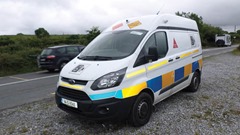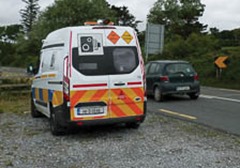Safety camera operations in Ireland
 Gerard Begley, from Egis Projects Ireland, explains how an intelligence-led approach to monitoring speed is saving lives.
Gerard Begley, from Egis Projects Ireland, explains how an intelligence-led approach to monitoring speed is saving lives.
In November 2010, Ireland saw the deployment of privatised, mobile safety cameras, using radar technology, as part of the Government’s Road Safety Strategy 2007-2012. The objective was to increase compliance with speed limits and reduce driving fatalities. As a result, vehicle speeds at locations with a speed-related collision history dropped, with the mobile cameras acting as a deterrent to excessive speeds, thereby reducing accidents in the areas where they were deployed. The operator is paid per hour of roadside traffic monitoring, not by infringements, underlining the focus on saving lives through modifying driver behaviour, rather than raising revenue. By 2010, Ireland had already seen a reduction in road fatalities of over 40 per cent relative to the numbers from 2001, and the introduction of mobile safety cameras was intended to support this momentum.
In the 12 months from the end of June 2005 to June 2006, there were 412 fatalities on Irish roads – an average of 34 deaths per month or an annualised 98 fatalities per million of population (population 4.2 million). In 2012, after just two years of the programme, road deaths had decreased to 13.5 deaths per month or an annualised 38 fatalities per million of the population.
Transport demographics
| Population 2013 (millions) | Road length (km) | Motor vehicles per 100 people (2008) | Vehicles per km | Population density | |
| Ireland | 4.58 | 97,000 | 513 | 24 | 66.4 |
| Finland | 5.43 | 79,000 | 532 | 36 | 17.7 |
| UK | 63.26 | 420,000 | 523 | 77 | 259.4 |
Key to the success was the intelligence led approach to speed enforcement by An Garda Síochána who manage the programme. This approach means enforcement priorities are guided by statistically-supported knowledge gathered from the key stakeholders involved in road safety, and the results are clear. The locations monitored by safety cameras (“collision-prone” zones) are selected by using analysis by An Garda Síochána of speed-related collisions over a five-year period, which ensures optimal deployment of the safety cameras at the locations and times where the collisions occur.
Monitoring only occurs within these zones and is weighted towards the times when collisions occur. Deployment is reviewed continually to ensure that most focus is placed on zones where drivers are less compliant with speed limits, thereby supporting the deterrent effect of the highly visible safety cameras.
In 2010 An Garda Síochána outsourced speed enforcement to GoSafe, a private, independent contractor to provide mobile safety cameras and deliver 7,475 hours per month of speed enforcement and speed surveying. GoSafe is an Egis Projects joint venture with MIL (Ireland) and Redflex (Australia). It operates 24 hours per day, seven days per week, and 365 days per year, across 727 designated zones, covering every county of Ireland. The camera vans monitor speeds across every county in the country and gather data that supports and contributes to the intelligence-led enforcement approach.
Ireland is a relatively small country with a high density of roads and a relatively low population density (see table).
 Given the demographics illustrated, mobile cameras allow coverage of a much larger area than fixed cameras.
Given the demographics illustrated, mobile cameras allow coverage of a much larger area than fixed cameras.
An Garda Síochána also opted for overt monitoring, with highly visible safety camera vans and the locations of all monitoring zones published on their website and provided for sat-navs, and all monitoring zones marked with roadside camera signs. The Road Safety Authority emphasised that the success of a road safety strategy “depends on the support of the community it serves and road users in particular”.
Halo effect
The ‘halo effect’ of mobile operations represents the length of time that the effects of enforcement on driver behaviour continues after the enforcement has ended and the distance over which the effects of enforcement continues after passing an enforcement site. This allows a relatively small number of mobile safety cameras to have a larger impact on driver behaviour than a similar number of fixed cameras.
And this approach is working. For example, between 29 May and 2 June 2014, GoSafe checked the speeds of 457,895 vehicles on Irish roads, almost 19 per cent of all registered vehicles in the country. The highly visible vans mean that over those five days up to one in five people driving in Ireland passed a safety camera van, all of which were operating in collision-prone zones. The actual driver compliance with speed limits monitored by the safety cameras during this period – a designated Road Safety Weekend – was 99 per cent.
The Use of Speed Cameras in Ireland report, commissioned by the National Road Authority, states: “This analysis should then be transformed into a strategy that identifies geographical areas and enforcement sites that allow for the optimum balance of general and specific deterrents in a manner that secures the achievement of ‘critical mass’ coverage of the driving population. Explained briefly, critical mass is the magnitude of outputs necessary (speed checks) for the driving population to develop the perception that if you exceed the speed limit, you face an unacceptable risk of being detected and prosecuted.”
The results are positive. An Garda Síochána reported to the Oireachtas Joint Committee on Transport and Communications on 16 April 2014 that in the five years prior to the commencement of GoSafe operations, approximately 30 per cent of fatal collisions annually were occurring in the “collision-prone” zones. In 2013, there was a reduction of 40 per cent of fatal collisions in these zones, which was a reduction of 23 road fatalities.
Speed survey and monitoring data in January 2011 showed that average compliance rates across all speed limits were 81 per cent. Similar data from January 2014 showed that average compliance rates across all speed limits were 95 per cent, an increase of 14 per cent.
There is further international evidence that safety cameras reduce collisions. Since the introduction of speed cameras in the UK in 1992, deaths on Britain’s roads have halved from 4,229 to 1,850 in 2009. Road safety has, of course, improved in many other ways, but there appear to be substantial data to support the effectiveness of cameras.
Anecdotal evidence and support was also provided by a 2011 article in the Guardian newspaper on the very public decision in July 2010 to switch off fixed safety cameras in Oxfordshire and then, following a review, to switch them back on in March 2011. In the 31 days before the cameras were switched off, the machines caught 2,286 speeding motorists. In the 30 days after they were switched back on, they caught 5,917.
The intelligence-led approach to focus on collision-prone zones with a highly visible presence of mobile safety cameras seems to be achieving critical mass and contributing to saving lives. Crucially, it has been supported by a very extensive media campaign by the Road Safety Authority to emphasise the need to reduce speeds in the collision-prone zones and thereby save lives.
 Egis Projects Ireland
Egis Projects Ireland
Unit 24, Northwood House
Northwood Business Park
Santry, Dublin 9
Tel: +353 1 469 1200
Email: General: information@egis.ie
Web: www.egis.ie





